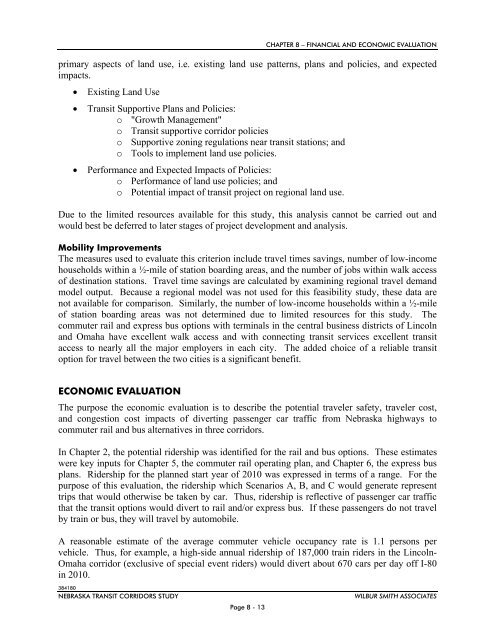NTRAC Final Study - Nebraska Department of Roads - State of ...
NTRAC Final Study - Nebraska Department of Roads - State of ...
NTRAC Final Study - Nebraska Department of Roads - State of ...
You also want an ePaper? Increase the reach of your titles
YUMPU automatically turns print PDFs into web optimized ePapers that Google loves.
CHAPTER 8 – FINANCIAL AND ECONOMIC EVALUATION<br />
primary aspects <strong>of</strong> land use, i.e. existing land use patterns, plans and policies, and expected<br />
impacts.<br />
Existing Land Use<br />
Transit Supportive Plans and Policies:<br />
o "Growth Management"<br />
o Transit supportive corridor policies<br />
o Supportive zoning regulations near transit stations; and<br />
o Tools to implement land use policies.<br />
Performance and Expected Impacts <strong>of</strong> Policies:<br />
o Performance <strong>of</strong> land use policies; and<br />
o Potential impact <strong>of</strong> transit project on regional land use.<br />
Due to the limited resources available for this study, this analysis cannot be carried out and<br />
would best be deferred to later stages <strong>of</strong> project development and analysis.<br />
Mobility Improvements<br />
The measures used to evaluate this criterion include travel times savings, number <strong>of</strong> low-income<br />
households within a ½-mile <strong>of</strong> station boarding areas, and the number <strong>of</strong> jobs within walk access<br />
<strong>of</strong> destination stations. Travel time savings are calculated by examining regional travel demand<br />
model output. Because a regional model was not used for this feasibility study, these data are<br />
not available for comparison. Similarly, the number <strong>of</strong> low-income households within a ½-mile<br />
<strong>of</strong> station boarding areas was not determined due to limited resources for this study. The<br />
commuter rail and express bus options with terminals in the central business districts <strong>of</strong> Lincoln<br />
and Omaha have excellent walk access and with connecting transit services excellent transit<br />
access to nearly all the major employers in each city. The added choice <strong>of</strong> a reliable transit<br />
option for travel between the two cities is a significant benefit.<br />
ECONOMIC EVALUATION<br />
The purpose the economic evaluation is to describe the potential traveler safety, traveler cost,<br />
and congestion cost impacts <strong>of</strong> diverting passenger car traffic from <strong>Nebraska</strong> highways to<br />
commuter rail and bus alternatives in three corridors.<br />
In Chapter 2, the potential ridership was identified for the rail and bus options. These estimates<br />
were key inputs for Chapter 5, the commuter rail operating plan, and Chapter 6, the express bus<br />
plans. Ridership for the planned start year <strong>of</strong> 2010 was expressed in terms <strong>of</strong> a range. For the<br />
purpose <strong>of</strong> this evaluation, the ridership which Scenarios A, B, and C would generate represent<br />
trips that would otherwise be taken by car. Thus, ridership is reflective <strong>of</strong> passenger car traffic<br />
that the transit options would divert to rail and/or express bus. If these passengers do not travel<br />
by train or bus, they will travel by automobile.<br />
A reasonable estimate <strong>of</strong> the average commuter vehicle occupancy rate is 1.1 persons per<br />
vehicle. Thus, for example, a high-side annual ridership <strong>of</strong> 187,000 train riders in the Lincoln-<br />
Omaha corridor (exclusive <strong>of</strong> special event riders) would divert about 670 cars per day <strong>of</strong>f I-80<br />
in 2010.<br />
384180<br />
NEBRASKA TRANSIT CORRIDORS STUDY<br />
Page 8 - 13<br />
WILBUR SMITH ASSOCIATES

















